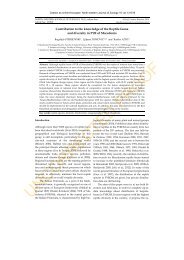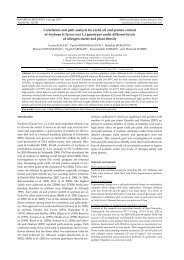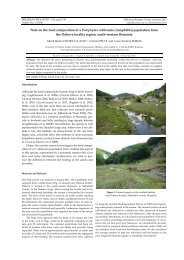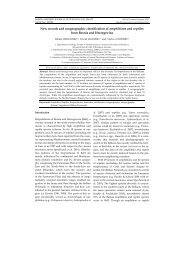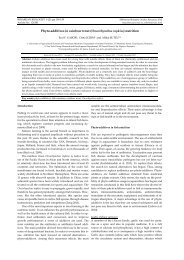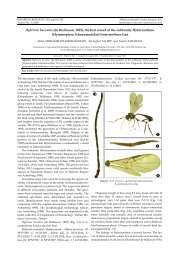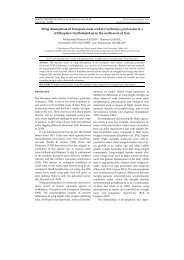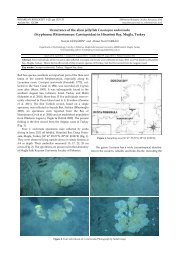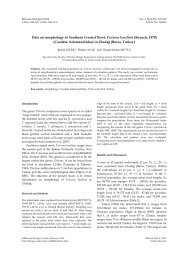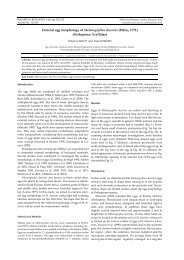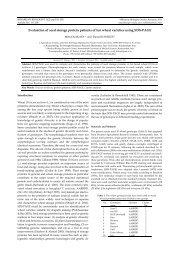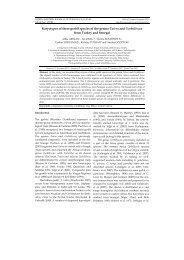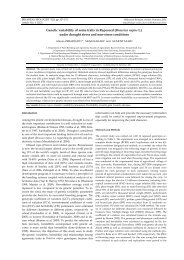Antimicrobial activity of Rosemary, Fennel and Galbanum essential ...
Antimicrobial activity of Rosemary, Fennel and Galbanum essential ...
Antimicrobial activity of Rosemary, Fennel and Galbanum essential ...
You also want an ePaper? Increase the reach of your titles
YUMPU automatically turns print PDFs into web optimized ePapers that Google loves.
BIHAREAN BIOLOGIST 5 (1): pp.4-7 ©Biharean Biologist, Oradea, Romania, 2011<br />
Article No.: 101102 http://biologie-oradea.xhost.ro/BihBiol/index.html<br />
<strong>Antimicrobial</strong> <strong>activity</strong> <strong>of</strong> <strong>Rosemary</strong>, <strong>Fennel</strong> <strong>and</strong> <strong>Galbanum</strong> <strong>essential</strong> oils<br />
against clinical isolates <strong>of</strong> Staphylococcus aureus<br />
Mohaddese MAHBOUBI 1,*, Nastaran KAZEMPOUR 1 <strong>and</strong> Mona MAHBOUBI 2<br />
1. Department <strong>of</strong> Microbiology, Biology Center <strong>of</strong> JundiShapour, 87135-1178 Kashan, Iran<br />
2. Department <strong>of</strong> Chemistry, School <strong>of</strong> Sciences, Payame Noor University, Ardakan, Iran.<br />
* Corresponding Author, M. Mahboubi, Tel: +98 866436 2112, Fax: +98 866436 2187, E- Mail: mahboubi57@yahoo.com<br />
Received: 16. August 2010 / Accepted: 29. November 2010 / Available online: 12. December 2010<br />
Abstract. The <strong>essential</strong> oils from rosemary (Rosmarinus <strong>of</strong>ficinalis L.), galbanum (Ferula gummosa), <strong>and</strong> fennel (Foeniculum vulgare)<br />
were obtained from Barij Essence Pharmaceutical Company <strong>and</strong> were analyzed by GC <strong>and</strong> GC-MS. The <strong>essential</strong> oils were evaluated<br />
for their anti-staphylococcal activities against Methicillin Sensitive (MSSA) <strong>and</strong> Resistant S. aureus (MRSA) by disc diffusion<br />
<strong>and</strong> micro broth dilution assays. GC-MS analysis <strong>of</strong> oils showed that β-pinene, α-pinene <strong>and</strong> trans-anethole as the major components<br />
<strong>of</strong> galbanum, rosemary <strong>and</strong> fennel oils, respectively. The Inhibition Zone diameters (IZ) <strong>of</strong> <strong>essential</strong> oils in disc diffusion assay<br />
increased in a dose dependent manner <strong>and</strong> in different concentrations <strong>of</strong> oils, the IZs were compatible with vancomycin (30 µg). Altogether,<br />
antimicrobial evaluations exhibited that galbanum oil had the best antimicrobial <strong>activity</strong> against MRSA <strong>and</strong> MSSA, followed<br />
by fennel <strong>and</strong> rosemary oil, respectively.<br />
Keywords: <strong>Rosemary</strong>; <strong>Fennel</strong>; <strong>Galbanum</strong>; Essential oil; Methicillin; Staphylococcus aureus.<br />
Introduction<br />
Staphylococcus aureus, a gram positive, non motile, catalase<br />
<strong>and</strong> coagulase positive, facultative anaerobe coccus is a<br />
common type <strong>of</strong> bacteria that normally lives on the skin <strong>and</strong><br />
nasal passages <strong>of</strong> healthy people. When it enters the body<br />
through a cut or other medical devices, it can cause local or<br />
serious infections (Franklin 1998). Methicillin Resistant S.<br />
aureus (MRSA) has become one <strong>of</strong> the major causes <strong>of</strong> nosocomial<br />
<strong>and</strong> community pathogens causing significant morbidity<br />
<strong>and</strong> mortality because there are multi drug resistant<br />
pathogens that are resistant to all penicillins, so the option<br />
antibiotics for treatment <strong>of</strong> MRSA infections are limited to<br />
antibiotics such as vancomycin, tigecycline, lincozolid <strong>and</strong><br />
mupirocin (Simor et al. 2007). The patterns <strong>of</strong> antimicrobial<br />
susceptibility <strong>of</strong> S. aureus have been changed worldwide <strong>and</strong><br />
it has been reported increasingly to be less effective. Development<br />
<strong>of</strong> mupirocin (dos Santos et al. 2007) <strong>and</strong> vancomycin<br />
(Appelbaum 2006) microbial resistance in MRSA has increased<br />
in settings with extensive use <strong>of</strong> these agents. Microbial<br />
resistances to conventional antibiotics <strong>and</strong> adverse effects<br />
<strong>of</strong> these agents have led to find new sources as antimicrobial<br />
agents. Medicinal plants have a long history <strong>of</strong> use<br />
as traditional medicines for treatment <strong>of</strong> different kinds <strong>of</strong><br />
ailments especially for infectious diseases.<br />
<strong>Galbanum</strong>, is one <strong>of</strong> the most important resins from<br />
roots <strong>and</strong> aerial parts <strong>of</strong> Ferula gummosa (Apiaceae) <strong>and</strong> is<br />
one <strong>of</strong> the most important rangel<strong>and</strong> products <strong>of</strong> Iran with<br />
high export dem<strong>and</strong> (Nadjafia et al. 2006). <strong>Galbanum</strong> is used<br />
traditionally as food flavor for treatment <strong>of</strong> some gastrointestinal<br />
disorders such as stomach pain, <strong>and</strong> as antileptic<br />
remedy for epilepsy, cholera <strong>and</strong> as wound healing remedy<br />
(Zargari 1995). <strong>Galbanum</strong> oil can be applied to neck or<br />
drunk for improving the memory (Adams et al. 2007).<br />
Foeniculum vulgare (Apiaceae) is a well-known Umbelliferous<br />
plant, commonly known as fennel. It is a perennial<br />
herb that grows all over the world <strong>and</strong> is used traditionally<br />
from ancient times as carminative, antiseptic, expectorant,<br />
digestive <strong>and</strong> diuretic agents. The seeds <strong>of</strong> fennel have been<br />
used to regulate menstruation, alleviate the symptoms <strong>of</strong><br />
female climacteric syndrome <strong>and</strong> dysmenorrheal <strong>and</strong> increased<br />
libido (Albert-Puleo 1980).<br />
Rosmarinus <strong>of</strong>ficinalis L. (Labiatae) commonly known as<br />
rosemary, traditionally used as antispasmodic <strong>and</strong> for<br />
treatment <strong>of</strong> dysmenorrhea, respiratory disorders, nervous<br />
ailments <strong>and</strong> to stimulate growth <strong>of</strong> the hair (Zargari 1995).<br />
The aim <strong>of</strong> this study was to evaluate the antistaphylococcal<br />
activities <strong>of</strong> rosemary, galbanum <strong>and</strong> fennel oils<br />
against clinical isolates <strong>and</strong> identifying the chemical composition<br />
<strong>of</strong> the <strong>essential</strong> oils related to it.<br />
Materials <strong>and</strong> Methods<br />
Essential oils <strong>and</strong> identification <strong>of</strong> chemical compositions <strong>of</strong> the oils<br />
The <strong>essential</strong> oils from aerial parts <strong>of</strong> rosemary, seeds <strong>of</strong> fennel <strong>and</strong> the<br />
resin <strong>of</strong> galbanum were prepared from Barij Essence Pharmaceutical<br />
Company, Kashan, Iran.<br />
The oil analysis was carried out using GC <strong>and</strong> GC/MS. The GC apparatus<br />
was Agilent technology (HP) 6890 system, capillary column <strong>of</strong><br />
HP-5MS (60 m × 0.25 mm, film thickness 0.25 µm). The oven temperature<br />
program was initiated at 40 °C, held for 1 min then raised up to 230 °C at<br />
a rate <strong>of</strong> 3 °C /min held for 10 min. Helium was used as the carrier gas at<br />
a flow rate 1.0 ml/min. The detector <strong>and</strong> injector temperatures were 250<br />
<strong>and</strong> 230 °C respectively. GC/MS analysis was conducted on a HP 6890<br />
GC system coupled with 5973 network mass selective detector with a capillary<br />
column the same as above, carrier gas helium with flow rate 1<br />
ml/min with a split ratio equal to 1/50, injector <strong>and</strong> oven temperature<br />
programmed was identical to GC. The compounds <strong>of</strong> the oil were identified<br />
by comparison <strong>of</strong> their retention indices (RI), mass spectra fragmentation<br />
with those on the stored Wiley 7n.1 mass computer library, <strong>and</strong><br />
NIST (National Institute <strong>of</strong> St<strong>and</strong>ards <strong>and</strong> Technology)(Adams 2001).<br />
Staphylococcal isolates<br />
Twelve clinical isolates <strong>of</strong> S. aureus cultured from patients <strong>and</strong> S. aureus<br />
ATCC 25923 were used in all experiments. Methicillin resistant S. aureus<br />
directed detected on CHROMagar TM MRSA (CHROMagar Paris, France).<br />
Bacterial suspensions were made in Brain Heart Infusion (BHI) broth to<br />
concentration <strong>of</strong> approximately 10 8 CFU/ml using st<strong>and</strong>ard routine spectrophometrical<br />
method. Subsequent dilutions were prepared from the<br />
above suspensions, which were then used in the tests.<br />
Disc diffusion method<br />
The disc diffusion method was employed for determination <strong>of</strong> antimicrobial<br />
<strong>activity</strong> <strong>of</strong> <strong>essential</strong> oil. Briefly, using a sterile cotton swab, above microbial<br />
suspensions was spread on the Mueller Hinton Agar (MHA)<br />
plates. Sterile paper discs (6 mm in diameter) were impregnated with 10,<br />
15, 20 µl <strong>of</strong> each oil <strong>and</strong> were placed on the inoculated plates. After re-
<strong>Antimicrobial</strong> <strong>activity</strong> <strong>of</strong> <strong>Rosemary</strong>, <strong>Fennel</strong> <strong>and</strong> <strong>Galbanum</strong> <strong>essential</strong> oils against clinical isolates <strong>of</strong> Staphylococcus aureus<br />
maining at 4 °C for 2 h, plates were incubated for 24 h at 37 °C. The<br />
diameters <strong>of</strong> the inhibition zones were measured in millimeters. All tests<br />
were performed in triplicate (NCCLS 2009).<br />
Determination <strong>of</strong> minimum inhibitory <strong>and</strong> bactericidal concentrations<br />
The minimum inhibitory concentration (MIC) <strong>and</strong> minimum bactericidal<br />
concentration (MBC) values <strong>of</strong> oil were determined by micro broth dilution<br />
assay. The oil was tw<strong>of</strong>old serially diluted with 10% DMSO containing<br />
32-0.0125 µl/ml <strong>of</strong> oil. These dilutions were prepared in a 96-well micro<br />
titter plate. Cation adjusted Muller Hinton broth was used as broth<br />
media. After shaking, 100 µl <strong>of</strong> oil was added to each well. The above microbial<br />
suspensions were diluted (1-5 x10 6 CFU/ml) <strong>and</strong> then 100 µl was<br />
added to each well <strong>and</strong> incubated at 35 °C. MIC was defined as the lowest<br />
concentration <strong>of</strong> oil that inhibits bacteria after 24. MBC value was the first<br />
well that showed no growth on Manitol Salt Agar (NCCLS 2009).<br />
Results<br />
Analyses <strong>of</strong> galbanum oil revealed forty four components<br />
which accounted for 100% <strong>of</strong> the total composition <strong>of</strong> oil, βpinene<br />
(43.1%) <strong>and</strong> α-pinene (5.4%) were the main component<br />
<strong>of</strong> <strong>essential</strong> oil followed by β-cubebene (4.9%), epibicyclosesquiphell<strong>and</strong>rene<br />
(4.4%), p-cymene <strong>and</strong> 4-terpineol<br />
(4.1%) (Table 1).<br />
Table1. Chemical composition <strong>of</strong> F. gummosa <strong>essential</strong> oil<br />
( aRI: Retention Index).<br />
α- thujene<br />
α- pinene<br />
β- pinene<br />
β- myrcene<br />
3-carene<br />
p-cymene<br />
β- phell<strong>and</strong>rene<br />
1-limonene<br />
Compounds<br />
Trans sabinene hydrate<br />
Cis sabinene hydrate<br />
4-terpineol<br />
cyclosativene<br />
α- copaene<br />
β-elemene<br />
alloaromadendrene<br />
Delta selinene<br />
Epi-bicyclosesquiphell<strong>and</strong>rene<br />
soledene<br />
Gamma-cadinene<br />
α-amorphene<br />
Cis calamenene<br />
Delta cadinene<br />
eremophilene<br />
β- bisabolene<br />
spathulenol<br />
guaiol<br />
Cadina-1,4-diene<br />
Beta cubebene<br />
bulnesol<br />
14-norcadin-5-en-4-one isomer A<br />
viridiflorol<br />
RI a<br />
852<br />
860<br />
905<br />
915<br />
931<br />
942<br />
946<br />
949<br />
980<br />
1007<br />
1080<br />
1276<br />
1288<br />
1303<br />
1334<br />
1341<br />
1351<br />
1374<br />
1384<br />
1385<br />
1387<br />
1390<br />
1393<br />
1404<br />
1442<br />
1459<br />
1476<br />
1506<br />
1528<br />
1532<br />
1534<br />
(%)<br />
2.5<br />
5.4<br />
43.1<br />
Thirty three components were identified from rosemary<br />
<strong>essential</strong> oil representing 89.8% <strong>of</strong> the total oil. The major<br />
components were α-pinene (21.5%) <strong>and</strong> 1,8-cineole (15.2%)<br />
0.6<br />
0.6<br />
4.1<br />
0.3<br />
0.8<br />
1.2<br />
1.2<br />
4.1<br />
0.6<br />
0.7<br />
0.6<br />
0.8<br />
1.7<br />
4.4<br />
0.6<br />
4.1<br />
1.8<br />
1.0<br />
2.0<br />
0.7<br />
0.8<br />
2.7<br />
0.9<br />
0.8<br />
4.9<br />
1.2<br />
1.4<br />
0.6<br />
followed by verbenone (8.6%), camphor (6.8%) <strong>and</strong> camphene<br />
(6.3%) (Table 2).<br />
Among twenty six identified components <strong>of</strong> fennel oil,<br />
representing 99.9% <strong>of</strong> total composition, trans-anethole<br />
(56.6%), β-thujone (13.2%) were found as the major compounds.<br />
p-anisaldehyde (8.7%), fenchone (7.42%) were other<br />
main components <strong>of</strong> fennel oil (Table 3).<br />
The antistaphylococcal <strong>activity</strong> <strong>of</strong> <strong>essential</strong> oils by disc<br />
diffusion method exhibited that this effect increased in a<br />
dose dependent manner. Inhibition zone diameters <strong>of</strong> galbanum,<br />
fennel <strong>and</strong> rosemary oils were in compatible with vancomycin<br />
(30 μg) at 10, 15, >20 μl <strong>of</strong> oils, respectively.<br />
Table2. Chemical composition <strong>of</strong> R. <strong>of</strong>ficinalis L. <strong>essential</strong> oil.<br />
Compounds<br />
tricyclene<br />
α- pinene<br />
camphene<br />
β- pinene<br />
3-octanone<br />
β- myrcene<br />
p-cymene<br />
1,8-cineole<br />
1-limonene<br />
Linalool<br />
chrysanthenone<br />
Camphor<br />
borneol<br />
4-terpineol<br />
verbenone<br />
(+)-2,2,3-trimethylcyclopent-<br />
3-ene-1-ethanol<br />
geraniol<br />
Borneol acetate<br />
Trans caryophyllene<br />
Caryphyllene oxide<br />
RI<br />
844<br />
863<br />
873<br />
898<br />
900<br />
914<br />
944<br />
950<br />
951<br />
1015<br />
1018<br />
1038<br />
1069<br />
1077<br />
1097<br />
1102<br />
1151<br />
1174<br />
1321<br />
1433<br />
(%)<br />
0.5<br />
21.5<br />
6.3<br />
3.5<br />
0.8<br />
1.6<br />
3.0<br />
15.2<br />
Table3. Chemical composition <strong>of</strong> F. vulgare L. <strong>essential</strong> oil.<br />
Compounds<br />
α- pinene<br />
sabinene<br />
β-pinene<br />
β- myrcene<br />
p-cymene<br />
1,8-cineole<br />
1-limonene<br />
fenchone<br />
camphor<br />
p-allylanisole<br />
carvone<br />
m-anisaldehyde<br />
p-anisaldehyde<br />
Trans anethole<br />
β-thujaplicin<br />
1-m-anisyl-1-propanone<br />
1-(4-methoxyphenyl)-2-methyl-6methoxy<br />
benzimidazole<br />
1-propanone,1-(4-methoxy phenyl)<br />
RI<br />
855<br />
892<br />
894<br />
912<br />
936<br />
942<br />
948<br />
992<br />
1032<br />
1089<br />
1122<br />
1126<br />
1141<br />
1185<br />
1269<br />
1320<br />
2103<br />
2161<br />
2.8<br />
2.6<br />
1.0<br />
6.8<br />
8.6<br />
1.5<br />
8.6<br />
1.0<br />
1.8<br />
6.1<br />
1.7<br />
1.7<br />
(%)<br />
0.4<br />
0.2<br />
0.1<br />
0.1<br />
0.2<br />
0.3<br />
4.2<br />
7.42<br />
0.3<br />
3.4<br />
1.4<br />
1.4<br />
8.7<br />
56.6<br />
13.2<br />
The diameter <strong>of</strong> growth inhibition zones ranged from<br />
11.6-34.2 mm at 10-20 μl <strong>of</strong> galbanum oil with the highest in-<br />
0.2<br />
0.2<br />
0.7<br />
5
6<br />
hibition zone value observed 25.6 mm at 10 μl <strong>of</strong> <strong>essential</strong><br />
oil.<br />
<strong>Fennel</strong> oil had antistaphylococcal <strong>activity</strong> with IZ <strong>of</strong> 7.2-<br />
24.1 mm at 20 μl <strong>of</strong> <strong>essential</strong> oil, the highest IZ was related to<br />
2 clinical isolates <strong>of</strong> S. aureus in the ranges <strong>of</strong> 21.9-24.1 mm.<br />
10 μl <strong>of</strong> <strong>Galbanum</strong> oil against under study isolates showed<br />
that seven isolates had IZ upper than 15 mm. 15 μl <strong>of</strong> fennel<br />
oil on 13 isolates <strong>of</strong> S. aureus showed that 3 isolates had IZ<br />
upper than 15 mm. <strong>Rosemary</strong> oil had IZs in the ranges <strong>of</strong><br />
7.9-15.2 mm. At 20 μl <strong>of</strong> oil, the IZs <strong>of</strong> all isolates were lower<br />
than that <strong>of</strong> 15 mm, disc diffusion assay exhibited that galbanum<br />
oil had the best antistaphylococcal <strong>activity</strong> followed<br />
by fennel <strong>and</strong> rosemary oil, respectively (Table 4).<br />
In quantitatively test, the MIC, MBC values <strong>of</strong> galbanum,<br />
fennel, rosemary oils were in the ranges <strong>of</strong> 8-32, 4-32, 8-32<br />
μl/ml. nine, eight, nine out <strong>of</strong> 13 isolates <strong>of</strong> S. aureus had the<br />
MIC values <strong>of</strong> 8, 16, 16 μl/ml for galbanum, fennel, rosemary<br />
oils, respectively. The almost MBC values for galbanum,<br />
fennel, rosemary oils were 16, 32, 32 μl/ml (Table 5).<br />
Discussion<br />
Mahboubi, M. et al.<br />
Three tested <strong>essential</strong> oils exhibited different degrees <strong>of</strong> antimicrobial<br />
activities against clinical isolates <strong>of</strong> S. aureus. The<br />
maximum anti-staphylococcal <strong>activity</strong> was shown by galbanum<br />
oil, followed by fennel <strong>and</strong> rosemary oils. Eftekhar et al<br />
(2004) reported the antibacterial <strong>activity</strong> <strong>of</strong> 25 μl <strong>of</strong> galbanum<br />
oil with β-pinene (50.1%) <strong>and</strong> α-pinene (18.3%) as main<br />
components by disc diffusion test against S. aureus ATCC<br />
25923. <strong>Galbanum</strong> oil containing α-pinene (14.3%), β-pinene<br />
(14.1%) <strong>and</strong> sabinene (40.1%) inhibited the growth <strong>of</strong> S.<br />
aureus at MIC value <strong>of</strong> 3.125 μl/ml (Abedi et al. 2008). In this<br />
study, the chemical composition <strong>of</strong> galbanum oil is like as<br />
Eftekhar et al study (2004) <strong>and</strong> sabinene was not found in<br />
chemical composition <strong>of</strong> under study galbanum oil.<br />
The antimicrobial <strong>activity</strong> <strong>of</strong> galbanum oil can be explained<br />
by its main components. β-pinene <strong>and</strong> α-pinene are<br />
bicycle monoterpene hydrocarbon <strong>and</strong> are precursors <strong>of</strong><br />
many flavors <strong>and</strong> fragrances. α-pinene finds in sage, signi-<br />
Table 4. Antistaphylococcal <strong>activity</strong> <strong>of</strong> <strong>essential</strong> oils by disc diffusion method.<br />
(MR=Methicillin Resistance; MS=Methicillin Sensitive; *= millimeter)<br />
<strong>Galbanum</strong> oil (µl)<br />
Inhibition Zone Diameters (mm*)<br />
<strong>Fennel</strong> oil (µl) <strong>Rosemary</strong> oil (µl)<br />
Vancomycin<br />
10 15 20 10 15 20 10 15 20<br />
(µg)<br />
S.aureus SA32 MR 12.9±0.1 14.5±0.7 18.4±0.8 10.9±0.1 16.3±0.4 24.1±0.1 11.7±0.4 13.4±0.2 14.1±0.1 17.65±0.21<br />
S.aureus SA3 MR 25.6±0.1 35.5±0.7 34.2±1.7 12.1±0.1 16.2±0.5 21.9±0.2 8.6±1.9 9.9±1.5 12.1±0.1 19.1±0.14<br />
S.aureus SAanimal MR 16.4±0.6 16.8±0.2 17.5±0.6 10.0±0.6 10.8±0.3 12.3±0.4 7.9±0.1 8.1±0.1 10.1±0.1 18.5±0.14<br />
S.aureus SA4 MR 10±0.3 14.3±0.4 15.7±0.5 8.7±0.1 11.4±0.4 13.1±0.1 8.1±0.4 9.3±0.3 10.7±0.5 17.95±0.35<br />
S.aureus SA26 MR 15.4±0.1 16.4±0.1 20.4±0.0 9.45±0.1 10.2±0.4 12.0±0.0 9.4±0.9 10.3±1.3 11.6±0.5 18.8±0.14<br />
S.aureus SA27 MS 14.6±0.6 18.6±0.4 21.5±0.7 11.1±0.5 12.3±0.4 13.1±0.1 10.0±0.0 11.2±0.1 12.4±0.1 17.95±0.07<br />
S.aureus SA6538 MS 20.2±0.3 23.8±0.3 26.7±0.5 14.4±1.3 14.4±0.6 16.5±0.6 7.8±0.3 8.8±0.3 9.7±0.42 19.1±0.77<br />
S.aureus SA25923 MS 15.8±0.4 19.4±0.2 22.7±0.4 8.7±0.6 10.9±0.1 12.3±0.4 8.5±0.7 8.8±0.3 10.1±0.1 20.2±0.28<br />
S.aureus SA8 MS 11.6±0.5 13.9±0.0 16.2±0.3 13.3±0.1 14.0±0.3 16.1±0.1 8.0±0.1 9.3±0.6 9.5±0.71 19.6±0.28<br />
S.aureus SA6 MR 13.0±0.0 16.3±0.4 17.9±0.1 9.9±0.8 14.1±0.1 16.0±0.1 9.7±1.2 13.3±0.4 15.2±0.3 24.6±0.98<br />
S.aureus SA 31 MR 12.4±0.7 16.4±0.7 17.8±0.4 8.5±0.4 10.9±0.7 12.5±0.3 11.6±0.4 13.2±0.3 14.1±0.1 21.8±0.28<br />
S.aureus SA 33 MS 17.7±0.9 22.9±0.1 25.0±0.1 12.9±1.2 15.6±0.1 18.1±0.1 9.0±0.7 9.9±0.1 10.7±0.4 22.2±0.56<br />
S.aureus SA 34 MR 20.0±0.0 24.2±0.3 26.7±0.5 9.9±0.8 13.4±0.0 14.5±0.1 11.0±0.2 10.9±0.9 12.7±0.6 21.9±0.99<br />
Table 5. The antistaphylococcal <strong>activity</strong> <strong>of</strong> <strong>essential</strong> oils by micro broth dilution assay.<br />
[MIC = Minimal Inhibitory Concentration; MBC=minimal bactericidal cincentration]<br />
<strong>Galbanum</strong> oil<br />
(µl/ml)<br />
<strong>Fennel</strong> oil<br />
(µl/ml)<br />
<strong>Rosemary</strong> oil<br />
(µl/ml)<br />
Vancomycin<br />
(µg/ml)<br />
MIC MBC MIC MBC MIC MBC MIC MBC<br />
S. aureus 25923 16 32 16 32 16 32 1 2<br />
S. aureus SA4 8 8 16 32 8 8 1 2<br />
S. aureus SA8 8 8 16 32 8 8 0.5 0.5<br />
S. aureus SA6 8 8 16 32 8 8 1 2<br />
S. aureus SA3 8 16 16 32 8 16 1 1<br />
S. aureus SA34 16 32 16 32 16 32 1 2<br />
S. aureus SA animal 16 32 16 32 16 32 0.5 1<br />
S. aureus SA 32 16 32 4 8 16 32 1 1<br />
S. aureus SA 33 8 16 8 16 16 32 1 1<br />
S. aureus SA 31 8 16 8 16 16 32 0.5 1<br />
S. aureus SA 27 8 16 8 16 16 32 0.5 0.5<br />
S. aureus SA 26 8 16 8 16 16 32 0.5 0.5<br />
S. aureus SA 6538 8 16 16 32 16 32 1 2
<strong>Antimicrobial</strong> <strong>activity</strong> <strong>of</strong> <strong>Rosemary</strong>, <strong>Fennel</strong> <strong>and</strong> <strong>Galbanum</strong> <strong>essential</strong> oils against clinical isolates <strong>of</strong> Staphylococcus aureus<br />
rosemary oils that have been shown to have very different<br />
spasmogenic effects (Lis-Blachin et al. 1999) <strong>and</strong> is able to<br />
inhibit significantly the growth <strong>and</strong> cell viability <strong>of</strong> gram<br />
positive bacteria (Leite et al. 2007). The MIC value <strong>of</strong> 13.6<br />
μl/ml for α-pinene against S. aureus is reported (Pichette et<br />
al. 2006). β-pinene is well known monoterpene with antimicrobial<br />
<strong>activity</strong> (Dorman & Deans 2000). So, the antimicrobial<br />
<strong>activity</strong> <strong>of</strong> galbanum oil could be due to the Pinene-type<br />
monoterpene hydrocarbons (α-Pinene & β -Pinene).<br />
Trans-anethole is the most component <strong>of</strong> sweet fennel oil<br />
<strong>and</strong> reaches 84-90%, in this study the content <strong>of</strong> fenchone is<br />
about 7.4% <strong>and</strong> the amount <strong>of</strong> trans-anethole is about 57%.<br />
The antimicrobial <strong>activity</strong> <strong>of</strong> fennel oil investigated in different<br />
studies <strong>and</strong> the antimicrobial <strong>activity</strong> <strong>of</strong> fennel oil has<br />
been shown against S. aureus (Sagdic & Yasar 2005). Hammer<br />
et al (1999) found that fennel oil is active against S.<br />
aureus at concentration above 1%. Our study showed this oil<br />
is effective against S. aureus at 4-16 μl/ml. Patra et al. (2002)<br />
reported that anethole <strong>and</strong> its isomer are responsible for antimicrobial<br />
<strong>activity</strong> <strong>of</strong> fennel oil.<br />
The efflux inhibitory <strong>activity</strong> <strong>of</strong> rosemary oil is demonstrated<br />
(Oluwatuyi et al. 2004). Major constituents <strong>of</strong> rosemary<br />
oil were α-pinene <strong>and</strong> 1,8-cineole.<br />
1,8-cineole is a monocyclic terpene alcohol that does not<br />
induce autolysis <strong>of</strong> S. aureus but were found to cause leakage.<br />
It may permeabilize bacterial membranes <strong>and</strong> facilitate<br />
the entry <strong>of</strong> others (Carson et al. 2006). The percent <strong>of</strong> αpinene<br />
in rosemary oil is higher than that <strong>of</strong> galbanum oil<br />
but the antimicrobial <strong>activity</strong> <strong>of</strong> rosemary is lower than that<br />
<strong>of</strong> galbanum oil, so, other components in the oil such as 1,8cineole<br />
or β-pinene can affect on antibacterial <strong>activity</strong> <strong>of</strong> αpinene<br />
against S. aureus.<br />
Among three studied oils, galbanum oil is a suitable case<br />
for treatment <strong>of</strong> infectious diseases that are caused by S.<br />
aureus, some in vivo <strong>and</strong> clinical studies can be done for<br />
demonstration <strong>of</strong> the antistaphylococcal <strong>activity</strong> <strong>of</strong> galbanum<br />
oil.<br />
Acknowledgement. This study is supported by Barij Essence<br />
Pharmaceutical Company.<br />
References<br />
Abedi, D., Jalali, M., Asghari, G., Sadeghi, N. (2008): Composition <strong>and</strong><br />
antimicrobial <strong>activity</strong> <strong>of</strong> oleogumresin <strong>of</strong> Ferula gumosa Bioss. <strong>essential</strong> oil<br />
using Alamar Blue. Research in Pharmaceutical Sciences 3(1): 41-45.<br />
Adams, M., Gmunder, F., Hamburger, M. (2007): Plants traditionally used in<br />
age related brain disorders-a survey <strong>of</strong> ethnobotanical literature. Journal <strong>of</strong><br />
Ethnopharmacology 113: 363-381.<br />
Adams, R.P. (2001): Identification <strong>of</strong> <strong>essential</strong> oil by gas chromatography/quadrupole<br />
mass spectroscopy, Allured Publishing Corporation,<br />
Carol Stream, IL, USA.<br />
Albert-Puleo, M. (1980): <strong>Fennel</strong> <strong>and</strong> anise as estrogenic agents. Journal <strong>of</strong><br />
Ethnopharmacology 2: 337-344.<br />
Appelbaum, P.C. (2006): The emergence <strong>of</strong> vancomycin-intermediate <strong>and</strong><br />
vancomycin-resistant Staphylococcus aureus. Clinical Microbiology <strong>and</strong><br />
Infection 12 (Suppl.1): 16-23.<br />
Carson, C.F., Mee, B.J., Riley, T.V. (2002): Mechanism <strong>of</strong> action <strong>of</strong> Melaleuca<br />
alternifolia (tea tree) oil on Staphylococcus aureus determined by time-kill,<br />
lysis, leakage, <strong>and</strong> salt tolerance assays <strong>and</strong> electron microscopy.<br />
<strong>Antimicrobial</strong> Agents <strong>and</strong> Chemotherapy 48:1914-1920.<br />
Dorman, H.J.D., Deans, S.G. (2000): <strong>Antimicrobial</strong> agents from plants:<br />
antibacterial <strong>activity</strong> <strong>of</strong> plant volatile oils. Journal <strong>of</strong> Applied Microbiology<br />
88: 308-316.<br />
dos Santos, K.R.N., de Souza Fonseca, L., Filho, P.P.G. (1996): Emergence <strong>of</strong><br />
high-level mupirocin resistance in methicillin-resistant Staphylococcus aureus<br />
isolated from Brazilian university hospitals. Infection Control <strong>and</strong> Hospital<br />
Epidemiology 17: 813-816.<br />
Eftekhar, F., Yousefzadi, M., Borhani, K. (2004): Antibacterial <strong>activity</strong> <strong>of</strong> the<br />
<strong>essential</strong> oil from Ferula gummosa seed. Fitoterapia 75:758–759.<br />
Franklin, D.L. (1998): Staphylococcus aureus infection. The New Engl<strong>and</strong> Journal<br />
<strong>of</strong> Medicine 339 (8): 520-532.<br />
Hammer, K.A., Carson, C.F., Riley, T.V. (1999): <strong>Antimicrobial</strong> <strong>activity</strong> <strong>of</strong><br />
<strong>essential</strong> oils <strong>and</strong> other plant extracts. Journal <strong>of</strong> Applied Microbiology 86(6):<br />
985-990.<br />
Leite, A.M., Lima, E.D.O., de Souza, E.L., Melo Diniz, M.F.F., Trajano, V.N., de<br />
Medeiros, I.M. (2007): Inhibitory effect <strong>of</strong> β-pinene, α-pinene <strong>and</strong> eugenol on<br />
the growth <strong>of</strong> potential infectious endocarditis causing Gram-positive<br />
bacteria. Brazilian Journal <strong>of</strong> Pharmaceutical Sciences 43 (1):121-126.<br />
Lis-Balchin, M., Ochoka, R.J., Deans, S.G., Asztemborska, M., Hart, S., (1999):<br />
Differences in bio<strong>activity</strong> between the enantiomers <strong>of</strong> α-pinene. Journal <strong>of</strong><br />
Essential Oil Research 11: 393-397.<br />
Nadjafia, F., Bannayana, M., Tabrizia, L., Rastgoo, M. (2006): Seed germination<br />
<strong>and</strong> dormancy breaking techniques for Ferula gummosa <strong>and</strong> Teucrium polium.<br />
Journal <strong>of</strong> Arid Environments 64: 542-547.<br />
NCCLS (2009): Methods for dilution <strong>Antimicrobial</strong> susceptibility tests for<br />
bacteria that grow aerobically. Approved St<strong>and</strong>ard M7-A8, Eighth Edition,<br />
Wayne, PA.<br />
NCCLS (2009): Performance st<strong>and</strong>ard antimicrobial disc susceptibility testing,<br />
Thenth Edition, M02-A10, Wayne, PA.<br />
Oluwatuyi, M., Kaatz, G.W., Gibbons, S.G. (2004): Antibacterial <strong>and</strong> resistance<br />
modifying <strong>activity</strong> <strong>of</strong> Rosmarinus Officinalis. Phytochemistry 65: 3249-3254.<br />
Patra, M., Shahi, S.K., Midgely, G., Dikshit, A. (2002): Utilization <strong>of</strong> <strong>essential</strong> oil<br />
as natural antifungal against nail infective fungi. Flavour <strong>and</strong> Fragrance<br />
Journal 17: 91-94.<br />
Pichette, A., Larouche, P.L., Lebrun, M., Legault, J. (2006): Composition <strong>and</strong><br />
antibacterial <strong>activity</strong> <strong>of</strong> Abies balsamea <strong>essential</strong> oil. Phytotherapy Research 20<br />
(5): 371-373.<br />
Simor, A.E., Phillips, E., McGeer, A., Konvalinka, A., Loeb, M., Devlin, H.R.,<br />
Kiss, A. (2007): R<strong>and</strong>omized controlled trial <strong>of</strong> chlorhexidine gluconate for<br />
washing, intranasal mupirocin, <strong>and</strong> rifampin <strong>and</strong> doxycycline versus no<br />
treatment for the eradication <strong>of</strong> methicillin-resistant Staphylococcus aureus<br />
colonization. Clinical Infectious Diseases 44: 178-185.<br />
Sagdic, O., Yasar, A.N.K. (2005): Antibacterial effects <strong>of</strong> single or combined<br />
plant extracts. Annals <strong>of</strong> Microbiology 55: 67-71.<br />
Simor, A.E., Stuart, T.L., Louie, L., Watt, C., Ofner-Agostini, M., Gravel, D.,<br />
Mulvey, M., Loeb, M., McGeer, A., Bryce, E., Matlow, A. (2007): Mupirocin-<br />
Resistant, Methicillin-Resistant Staphylococcus aureus Strains in Canadian<br />
Hospitals. <strong>Antimicrobial</strong> Agents <strong>and</strong> Chemotherapy 51 (11): 3880-3886.<br />
Zargari, A. (1995): Medical Plants, 5th Edition, Tehran. University Press.<br />
7



